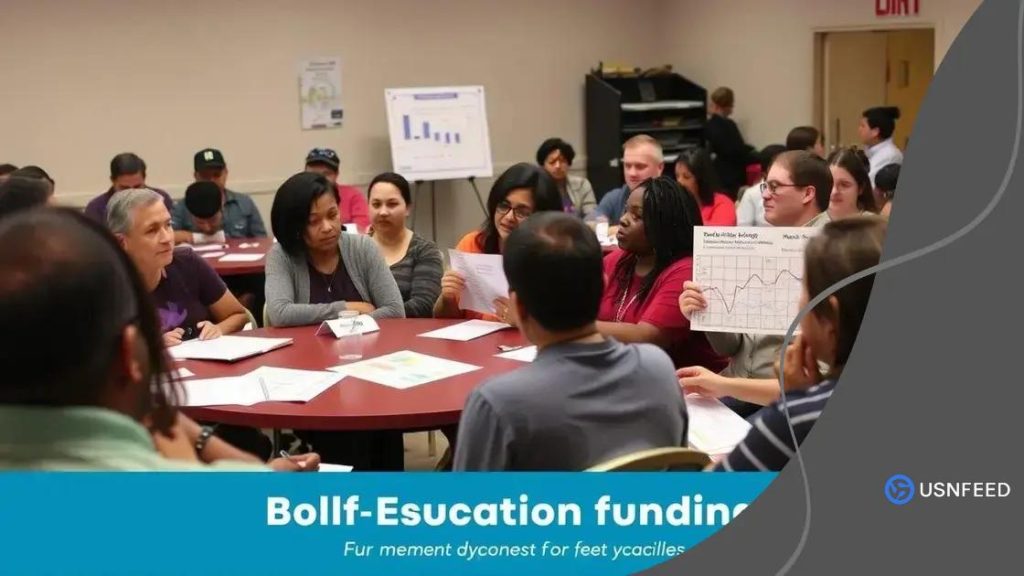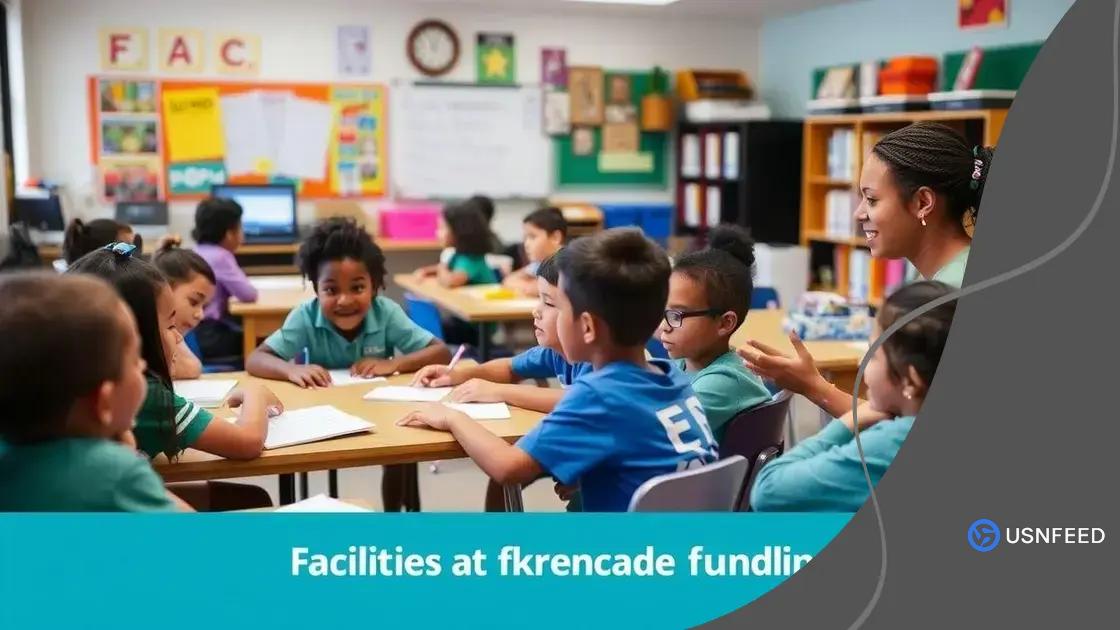Discussions on public education funding: what you need to know

Discussions on public education funding focus on how funding sources, community involvement, and alternative strategies impact school resources and student success.
Discussions on public education funding are more relevant than ever. You might be wondering how these conversations shape our educational landscape today. Let’s dive into this important topic and see what’s at stake.
Understanding public education funding
Understanding public education funding is crucial to grasping how our education system operates. It affects everything from teacher salaries to the condition of school facilities.
Many people may not realize the various sources of funding available. Public schools primarily receive money from state, local, and federal governments. Each of these funding sources plays a significant role in shaping the education that students receive.
Funding Sources
1. **State Funding**: This is often the largest source of revenue for public education. States allocate funds based on formulas that consider factors like enrollment numbers.
Local Funding
2. **Local Funding**: Local property taxes significantly impact school funding. This can lead to disparities, as wealthy areas tend to generate more revenue than others.
Federal Funding
3. **Federal Funding**: Although a smaller percentage, federal funds help support low-income students through programs like Title I. These programs aim to level the playing field.
Another aspect worth considering is the impact of funding on educational quality. Schools with more resources can offer advanced placement courses, extracurricular activities, and better facilities. In contrast, underfunded schools often struggle to meet basic educational needs.
Community involvement also plays a vital role in supporting education funding. When parents and local businesses participate, they can advocate for better funding and resources. Additionally, many communities hold fundraisers to supplement school budgets.
In essence, understanding public education funding helps everyone see the larger picture. It reveals why equal access to quality education is an ongoing challenge and underscores the importance of community advocacy in improving educational outcomes.
How funding decisions are made
Understanding how funding decisions are made is essential for grasping public education funding. Various factors influence how much money schools receive, shaping the resources and opportunities available to students.
One primary factor in funding decisions is government policy. Each state has its own laws and regulations that dictate how education funds are allocated. These policies can vary widely, leading to differences in funding levels across districts.
Distribution of Funds
Another crucial aspect is the distribution process. Funds may be allocated based on:
- Enrollment Numbers: Schools receive funding based on how many students are enrolled.
- Need-Based Funding: Some funds target schools with higher populations of low-income students.
- Special Programs: Schools that offer specific programs, like special education or bilingual education, may receive additional funds.
Beyond these factors, community input can also shape funding decisions. School boards often hold meetings to discuss budget needs. Parents, teachers, and community members have opportunities to voice their opinions. Their input can influence how funds are prioritized and spent.
Equity plays a significant role in the conversation about funding. Some districts argue that funding should be more equitable, ensuring all students receive quality resources, regardless of their community’s wealth. This ongoing debate can impact policy changes and funding formulas as communities advocate for fairer distribution.
Finally, external funding sources, such as grants and donations, can also affect how funding decisions are made. Many schools seek additional revenue through partnerships, fundraising events, and private donations to supplement their budgets. By understanding these various components, we gain insight into navigation of the funding landscape in public education.
The impact of funding on schools

The impact of funding on schools is significant and can influence everything from class size to the resources available for students. When schools receive adequate funding, they can offer a richer learning environment.
One of the most noticeable effects is on class size. More funding allows schools to hire additional teachers, which leads to smaller class sizes. This is important because smaller classes often lead to more personalized attention for students, helping them succeed academically.
Access to Resources
Funding also impacts the access schools have to various resources such as:
- Textbooks and Learning Materials: Adequate funding ensures that students have up-to-date materials to support their learning.
- Technology: Modern educational tools, like computers and tablets, enhance the learning experience.
- Extracurricular Activities: Funding can allow for a broader range of activities, including sports, music, and arts programs that keep students engaged.
In addition to resources, funding affects school facilities. Schools that are well-funded can maintain their buildings better, leading to safer and more conducive learning environments. Facilities with proper heating, air conditioning, and adequate classroom space help keep students and staff comfortable and focused.
Moreover, the level of funding can also influence teacher quality. Schools with competitive salaries are able to attract and retain highly qualified educators. A well-trained teacher can make a significant difference in student outcomes, leading to higher graduation rates and college enrollment.
Ultimately, the relationship between funding and educational outcomes is complex but clear. Schools with sufficient resources are better positioned to meet the diverse needs of their students, paving the way for academic success and future opportunities.
Exploring alternative funding sources
Exploring alternative funding sources is essential for supporting public education. Many schools face budget constraints and look beyond traditional funding methods to meet their needs.
One popular alternative funding source is grants. Various organizations, including the government and private foundations, offer grants to schools to support specific programs or initiatives. These grants can be for areas such as technology integration, arts education, or special projects aimed at improving student outcomes.
Fundraising Efforts
Another effective way schools raise money is through fundraising efforts. Schools often organize events like:
- Fun Runs: Students gather sponsors to raise money while participating in a fun activity.
- Bake Sales: Parents and students sell baked goods to generate funds for school programs.
- Auctions: Schools may host silent auctions where community members bid on donated items or services.
In addition to these activities, some schools establish partnerships with local businesses. Companies can provide sponsorship or donations in exchange for marketing opportunities. This collaboration can benefit both the school and the business involved.
Another avenue worth considering is the use of crowdfunding platforms. Websites like GoFundMe or DonorsChoose allow teachers or schools to raise money for specific projects or needs directly from the community. This method empowers parents, alumni, and other supporters to contribute to their local schools.
Finally, schools can explore federal and state programs designed to support education funding. Programs targeted at low-income schools, Title I funding, and other initiatives can provide valuable resources to help bridge funding gaps.
By actively seeking alternative funding sources, schools can enhance educational experiences and ensure that all students have access to the resources they need to succeed.
Community involvement in education funding
Community involvement in education funding is vital for enhancing the resources available to schools. When community members engage in supporting local schools, they contribute to creating a more enriching educational environment.
One way communities can get involved is through volunteering. Parents and local residents can mentor students, assist in classrooms, or help organize events. This direct involvement not only supports teachers but also demonstrates to students that their education matters.
Fundraising and Support
Another essential aspect of community involvement is participating in fundraising activities. Many schools organize events like:
- Charity Events: These can range from fun runs to gala dinners where proceeds go directly to support school programs.
- Local Business Sponsorships: Businesses can partner with schools, providing resources in exchange for advertising.
- Grants and Donations: Communities can help identify and apply for grants that benefit education.
In addition to financial support, communities can advocate for better funding from local governments. When residents actively participate in school board meetings or town halls, they can voice their opinions on funding needs. This advocacy ensures that the concerns of parents and taxpayers are heard.
Moreover, local organizations, such as non-profits and clubs, play a significant role in supporting schools. They often run programs that fill gaps where school funding falls short, especially in areas like arts and sciences. This partnership allows schools to offer diverse programs that enrich student learning experiences.
Ultimately, when communities come together to support education, they foster a sense of ownership and pride. This collaborative spirit not only enhances resources but also builds strong relationships among students, parents, and educators, leading to a brighter future for all involved.
FAQ – Frequently Asked Questions about Public Education Funding
What are the main sources of funding for public schools?
Public schools primarily receive funding from state, local, and federal governments, with local property taxes playing a significant role.
How can communities get involved in supporting schools?
Communities can volunteer, participate in fundraising events, and advocate for better funding at local government meetings.
What impact does funding have on student success?
Adequate funding allows for smaller class sizes, better resources, and more extracurricular activities, all of which enhance student learning.
What alternative funding sources can schools explore?
Schools can explore grants, local business sponsorships, crowdfunding, and partnerships with community organizations to supplement their budgets.